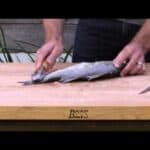What might be more tasty than fish? But, on the other side, nothing is worse than a cluttered fish-scaled tabletop, right?
That is why we have compiled this useful step-by-step guide to teach you how we may scale, gutting and cleaning fish like a master with or without the best fish scaler!
Gutting and Cleaning Fish Instructions
Required Tools of Gutting and Cleaning Fish
- Rubber gloves (optional)
- fish fillet knife
- Cutting board
- Best Spoon
- Running water
- A proper trash bin
Steps of Gutting and Cleaning Fish
Step 1- Slide the Knife Tip Within the Vent of the Fish.
- Line the fish over a stable cutting surface with the belly facing you.
- Lean the fish at an angle of 45-degree, and the head faces far from you.
- Make the fillet knife edge face the head of the larger fish. then slide the fish fillet knife end within the fish anus. Counting on the fish size, you can Insert the knife end from 1–2 inches (2.5–5.1 cm) within the vent.
Step 2-Cut the Way Up Toward the Neck.
- Hold your knife firmly and continue moving it up and down with a distance of 0.5 inches (1.3 cm) as you slide it along the fish opening.
- Keep cutting until you reach 1–2 inches (2.5–5.1 cm) under the fish’s mouth.
- You should avoid going deep within the belly of the fish while cutting it. If the intestines rupture, the fish inside will be messy.
Step 3-Open the Stomach and Take off the Guts and Intestines.
- When you do not rip the cut, distribute the fish on both sides with a diameter of 2-6 inches (5.1–15.2cm) slightly. Pinch the organs where they are connected with the head with your fingers.
- The organs are gently pulled out at the root. Then remove the intestines and guts. To see whether there are any organ residues, check the body cavity. Take them off with your hand if they are there.
- Put them in an adequate trash bin. It should be a straightforward task to physically remove guts, gills and intestine. There should be no resistance, and a knife to cut anything is not required.
Step 4-Extract the Kidney of the Fish Spine (If Found)
- Some big fish come with a tiny kidney on the interior of the spine close to the middle part.
- Search for a small organ that has a bean shape. If there is a kidney, extract it with a spoon.
Step 5-Rinse the Fish Under Running Water and Clean the Stomach Cavity.
- Grab the fish on the vent-side up in a large sink. Turn on a cold tap of water and open the stomach of the fish.
- Let the water pass through the fish’s stomach cavity. At the same time, clean the internal walls of the fish with a spoon or your hand. This step removes residues of organ and cleanses the meat.
- Maintain at least 1 minute washing of fish. This is done to guarantee that every part of the cavity of the fish gets reached.
Understanding How Fish Differs From Meat
Before starting the process of preparing fish, it’s important to know the difference between fish flesh and meat. This is mostly due to their muscular appearance.
Meat muscles and connectives are generally stiff and sinewy, which leads to long cooking or heat-intensive methods. In fish, on the other hand, muscle and connective tissues are far more responsive. This requires the cooking technique to be adjusted and the protein to ensure the delicate fish meat is not damaged.
Another aspect in the preparation of fish by Chefs is the determination of the group of flesh of the fish.
There are three major groups:
- Delicate
- Medium
- Firm
Was this helpful?
Hi there! I’m a food enthusiast and journalist, and I have a real passion for food that goes beyond the kitchen. I love my dream job and I’m lucky enough to be able to share my knowledge with readers of several large media outlets. My specialty is writing engaging food-related content, and I take pride in being able to connect with my audience. I’m known for my creativity in the kitchen, and I’m confident that I can be the perfect guide for anyone looking to take their culinary journey to the next level.








